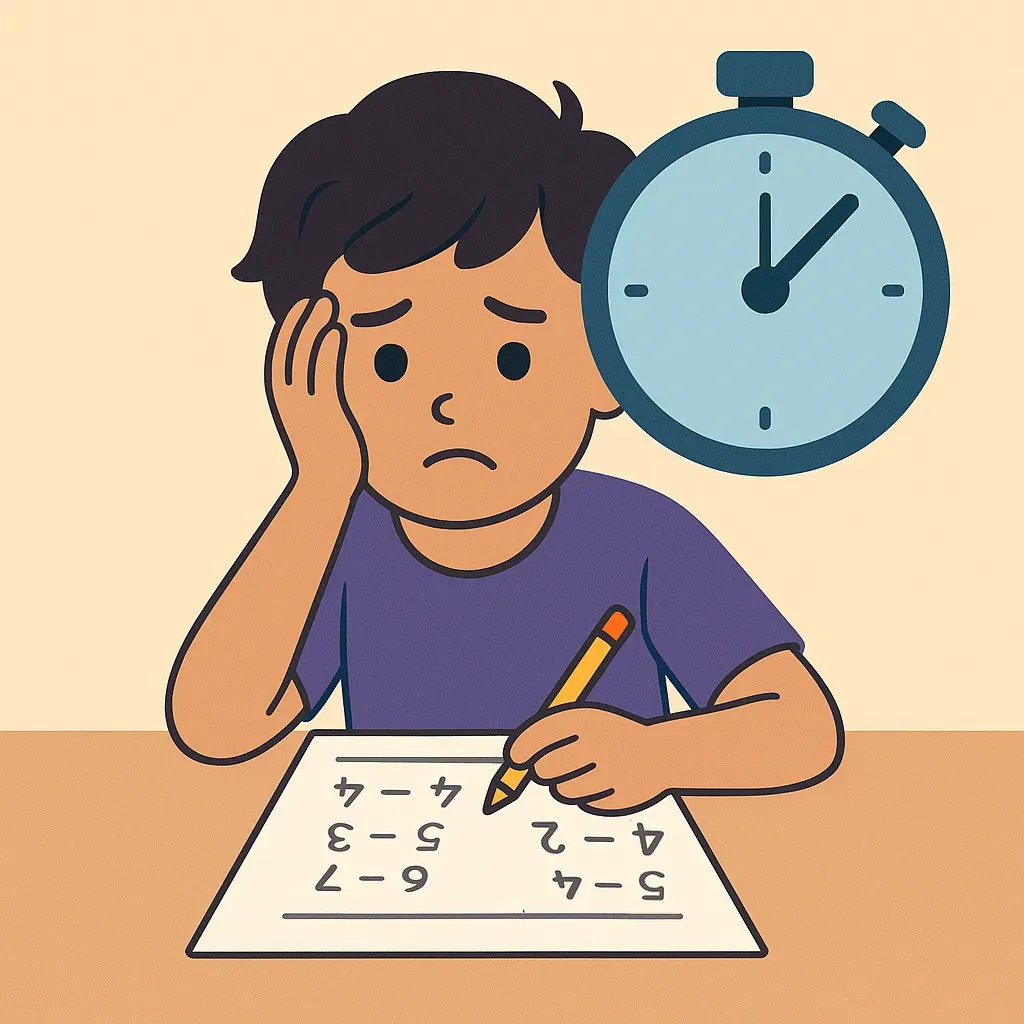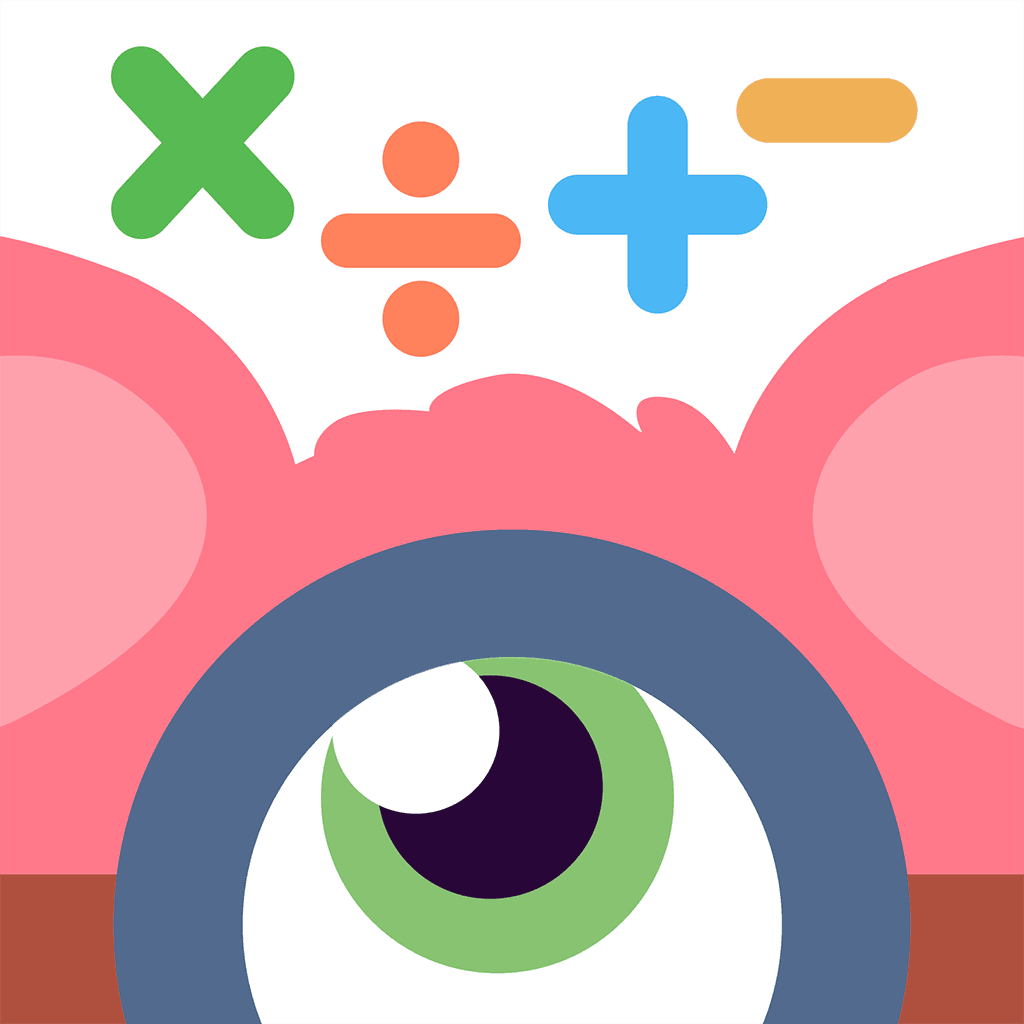ADHD & Math: 15 Parent-Approved Strategies to Help Your Child Thrive
1. Why ADHD Makes Math Feel “Sticky”
Attention lapses are only the headline. Functional-MRI studies show the ADHD brain’s frontostriatal loop refreshes working-memory buffers twice as fast as neurotypical peers, leaving fewer seconds to juggle multi-step calculations. That’s why a child may explain arrays perfectly on the sofa yet go blank when the worksheet arrives.
Our overview How ADHD Affects Math Learning maps each brain function to a classroom symptom (fidgeting, off-task talking, blank pages) and offers accommodation cheat-sheets you can hand to teachers.

Freeze moments happen when a task feels bigger than the dopamine reward. Share Why Your ADHD Child Freezes at Math with your child so they see the biology, then co-create a “reset plan” (stretch, sip water, re-read aloud, or even beatbox the question) to keep shame out of the picture.
2. Rote Drills vs Brain-Friendly Fluency
Twelve two-minute speed drills can produce less fact retention than six strategy rounds. Cortisol blocks hippocampal consolidation, and scans show the amygdala lights up after about 90 seconds of time pressure. Rote Memorisation Can Increase Anxiety explains the biology and offers a quick cortisol-reset routine (box breathing + silly walk break).
Not sure which approaches count as strategy? Math-Fact Strategies 101 ranks nearest-10, doubles-plus-one, and number-line hops by evidence strength. Also read what is Math Fact fluency in Master Math-Fact Fluency - focus on building a strong understanding of how operations and numbers work, rather than just focussing on fact recall. Automaticity in Fact recall is important - but it should be a result of Math fact fluency, not the goal in itself.
3. Whole-Child Factors: Sleep, Food, Sensory Load
Even mild sleep fragmentation drops computation scores by almost a full grade level. The “90-minute wind-down” in Can Sleep Efficiency Affect Math Learning? blends warm-light lamps, predictable rituals, and a “brain dump” journal that scrapes intrusive thoughts onto paper before bed.
Sensory tweaks lift stamina too. Overhead LEDs and metal chair legs drain self-regulation fast. Swap lamps for daylight bulbs, add a foot-swing band, and pop foam dots under the page so worksheets stop sliding—tiny tweaks lifted on-task time by 25 % in Sensory-Proofing Math Spaces.
4. Harnessing ADHD Strengths
Hyperfocus, spatial reasoning, and novelty-seeking aren’t side-effects - they’re engines. Shift the narrative with Unlocking Hidden ADHD Strengths; kids pick one strength card (e.g., “Idea Machine”) before each lesson and note how it helped.
When mental-set shifting stalls, colour-code strategy cue cards from Flexible Thinking in Math. Red = draw a picture, blue = write an easier related fact, green = skip then return. The physical flip becomes a kinesthetic “shift” trigger.
5. Game-Based & Movement Learning
Dopamine dips roughly every seven minutes; movement spikes it back. Rather than fight the wiggles, channel them:
- 5 Amazing Math Games inject cooperative play - kids “level up” together.
- Board Games ADHD Kids Love details rule tweaks (shorter rounds, visual score tracks).
- Multiplication iPad Apps rotate mini-quests every three minutes so attention never flat-lines.
- Movement-Powered Math turns place-value into hopscotch (jump by tens).
- Money-Learning Games and Activities anchor abstract value in real snacks - you “buy” apple slices with fake coins.
Extra tip: Build a five-card “Win & Spin” deck (idea in the Apps post). Each completed problem lets the child draw one card—dance break, mini-maze, or choose new avatar skin—to keep novelty tanks full.

6. Concrete-to-Abstract (CRA) & Visual Strategies
Base-ten blocks while narrating (“ten ones make a ten”) then sketch then symbol. The whole routine - and troubleshooting flowchart - lives in Parent’s CRA Guide.
For picture thinkers, try the one-pager “sketch note” template from Visual Math Strategies. For example, learners can draw a mini-comic of the story problem first - humour glues details to memory.
7. Early Number Sense & Subitizing
Rapid dot-cards beat finger counting. Subitizing games inside Building Early Math Skills take few minutes and can form an important foundation before going onto operations. At breakfast, flash cereal groups on a spoon and race to name totals - same idea, no prep.
8. Grade-Specific Boosters
Third grade: Master arrays first. Multiplication & Division Strategies slides from groups of objects to quick facts.
Fifth grade: Fractions stall many ADHD learners because they juggle two numbers at once. The visual approach in this iPad app anchors part & whole side-by-side so working memory can rest.
9. Executive-Function Boosters & Homework Hacks
Case study: Maya (Grade 4) cut meltdown time from 20 minutes to 3 by pairing a five-problem “first chunk” with a sand-timer and a wall chart of movement breaks. Her process lives in Self-Monitoring Hacks.
For homework time without pain, try the tips mentioned in the Math Homework Without Meltdowns. If story problems still unravel your child, scaffold working memory with ideas mentioned in It’s the Memory, Not the Numbers.
10. Growth Mindset & Motivation Scripts
One negative drill can cut voluntary practice for a week. Swap “You’re so smart” for “That new strategy paid off.” Script bank lives in Growth-Mindset Math: 7 Scripts.
Curious if confidence truly boosts grades? A 2023 meta-analysis summarised in Does Math Confidence Improve Success? shows a 0.34 effect size - roughly half a letter grade - when kids believe mistakes are growth signals. It definitely helps building your child's Math confidence along with their Math skills.
11. Advocacy & Self-Voice
Students who ask for their own movement break get fewer behaviour marks within one term. Role-play teacher conferences using Self-Advocacy Scripts so kids can specify what does and doesn’t help.
12. When ADHD Meets Dyscalculia
Dual diagnoses need dual supports - high-contrast visuals and timed sprints. Overlap guide lives in ADHD & Dyscalculia. Combine CRA blocks with a “two-minute dash” to embed both conceptual clarity and retrieval speed.
13. Curriculum & Productive Struggle
Visual approaches such as bar modelling help ADHD learners hold fractions. Compare curricula in Singapore Math & ADHD. Keep tasks in the “just-right challenge” zone - eight-to-twelve minutes per set maintains dopamine flow without meltdown.
14. Real-World Math Week Plan
Monday: Brainstorm store prices, play the “discount detective” game from Money Activities.
Tuesday: Two 5-minute iPad quests (Monster Math, Slice Fractions, etc.), then sketch note one problem.
Wednesday: Hopscotch Place-Value relay (Movement-Powered Math) outside.
Thursday: Array scavenger hunt in the kitchen (3×4 egg box).
Friday: Board-game night—pick one from the ADHD-friendly list.
Total structured math time = 45 minutes, but the variety keeps novelty and dopamine topped up.
15. Progress Tracking & Gamification
Create a “Math XP” wall. Every solved problem = 1 XP, every new strategy tried = 3 XP, every teaching-the-parent moment = 5 XP. Kids spend XP on movement breaks, choosing the next game, or a special snack. Token systems boost intrinsic motivation by converting abstract effort into visible progress.
FAQs for Parents
Ideal homework length?
10–15 minutes times grade level, split into 5-minute sprints with 2-minute movement resets.
Are calculators cheating?
Once the concept is solid, calculators free working memory for reasoning - but they can rob the child of valuable Math fact practice. Ideally avoid it till they build strong Math fact fluency themselves. In higher grades, it can definitely help, since doing the math facts is not the primary challenge.
Does medication fix maths struggles?
Medication steadies attention and can decrease it by quite a bit, but visuals, movement, and explicit strategy instruction remain essential to achieve good learning outcomes.
Next Reads & Bookmark-Worthies
Monster Math is built so every child—especially wonderfully wiggly ADHD brains—can master number sense through play, patterns, and positive feedback.

